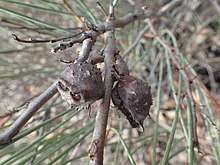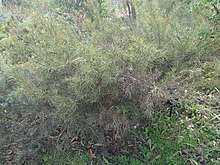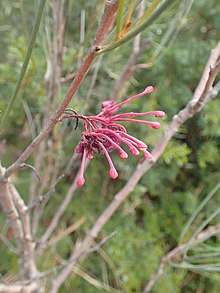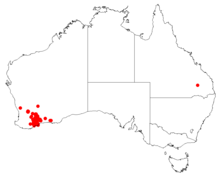Hakea strumosa
Hakea strumosa is a shrub in the family Proteacea endemic to an area in the Wheatbelt, Great Southern and the Goldfields-Esperance regions of Western Australia. A dense, very prickly shrub with a profusion of small, deep pink or red flowers in spring.[2]


| Hakea strumosa | |
|---|---|
 | |
| Hakea strumosa flowers in Kings Park, Perth | |
| Scientific classification | |
| Kingdom: | Plantae |
| Clade: | Tracheophytes |
| Clade: | Angiosperms |
| Clade: | Eudicots |
| Order: | Proteales |
| Family: | Proteaceae |
| Genus: | Hakea |
| Species: | H. strumosa |
| Binomial name | |
| Hakea strumosa Meisn.[1] | |
 | |
| Occurrence data from Australasian Virtual Herbarium | |
Description
Hakea strumosa is a rounded, dense shrub typically growing to a height of 0.6 to 1.5 metres (2 to 5 ft) and 1–2 m (3–7 ft) wide and does not form a lignotuber. The branchlets and young leaves are smooth or has dense, flattened, rusty-coloured silky hairs. The leaves are stiff, needle-shaped 2.5–11 cm (0.98–4.33 in) long and 1.3–1.8 mm (0.051–0.071 in) wide ending in a long sharp point 1–4.8 mm (0.039–0.189 in) long. The inflorescence usually consists of 4 and occasionally 6-10 small, deep pink or red mildly scented flowers in axillary clusters along the upright branchlets. The individual flowers have overlapping bracts 0.7–2 mm (0.028–0.079 in) long and covered in coarse, rough hairs. The pedicel 2–3.5 mm (0.079–0.138 in) long and smooth, the pistil 6.5–8 mm (0.26–0.31 in) long. The red and yellow perianth is 3–4.2 mm (0.12–0.17 in) long, smooth and covered in a bluish-green powdery film. The large fruit are smooth with wrinkles, pear-shaped 3–6 cm (1–2 in) long and 2–3.5 cm (0.8–1 in) wide, ending in two small horns 2 mm (0.08 in) long. Flowering occurs from September to October.[3][4][5]
Taxonomy and naming
Hakea strumosa was first formally described by Carl Meisner in 1855 and published the description in Prodromus Systematis Naturalis Regni Vegetabilis.[6][7] Named from the Latin strumosus - a reference to the thick stalk supporting the fruit.[5]
Distribution and habitat
This species is found growing in low heath on sand, sometimes over laterite from Tammin in the central wheatbelt, ranging south to Bremer Bay and Esperance.[5][3]
Conservation status
Hakea strumosa is classified as "not threatened" by the Western Australian Government Department of Parks and Wildlife.[2]
References
- "Hakea strumosa". Australian Plant Census. Retrieved 21 August 2019.
- "Hakea strumosa". FloraBase. Western Australian Government Department of Parks and Wildlife.
- Young, J A. Hakeas of Western Australia:A Field and Identification Guide. J A Young. ISBN 0-9585778-2-X.
- Holliday, Ivan. Hakeas: A Field and Garden Guide. Reed New Holland. ISBN 1-877069-14-0.
- "Hakea strumosa". Government of South Australia. Retrieved 13 November 2018.
- "Hakea strumosa". Australian Plant Name Index. Retrieved 21 August 2019.
- Meisner, Carl. "Hakea strumosa". Biodiversity Heritage Library. Retrieved 21 August 2019.